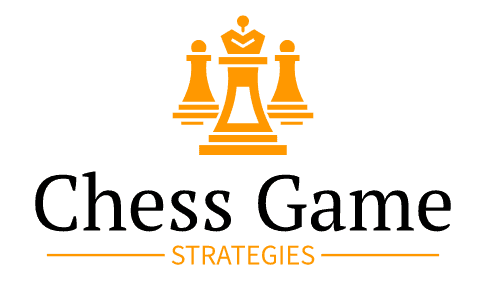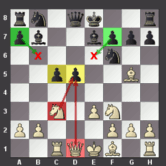
About This Article…
This article includes my notes, additional images and interactive chess positions from my study of Yasser Seirawan’s book, Winning Chess Strategies.
Source:
Winning Chess Strategies,
Revised edition
ISBN: 978-1-85744-385-1
Chapter 6. The Creation of Targets (p137-146)
- #1: A collection of Weak Pawns.
- #2: Acceptable Weak Pawns.
- #3: Minority Attack.
- #4: A more common Minority Attack.
Weak Pawns as Targets
Yasser Seirawan alludes to the fact that the greatest chess players all share the same trait of being able to identify targets, hunt them down, capture them and then search out their next victim, which they’ll pursue with the same vigor.
A Pawn is said to be Weak if it’s significantly vulnerable to attack.
The following types are all considered to be Weak Pawns, which are ripe for targeting:
If you own such Weak Pawns, as the six types just mentioned, then, providing enemy material cannot attack your Weak Pawn(s), their weakness is less of a problem to you.
If you spot Weak Pawns in your opponent’s army, keep in mind that enemy positions can be quick to collapse when Weak Pawns are targeted and attacked.
With all that in mind, here’s an interesting quote from Yasser Seirawan, to avoid unnecessary concern if you find yourself with a supposed Weak Pawn (or three):
“Why should the words isolated, doubled, or backward signify that a pawn is weak? In chess, a pawn or square is only weak if it can be attacked. If an enemy piece cannot get your pawn, then there is no reason to worry about its safety, regardless of whether it is isolated, doubled, or backward.”
Yasser Seirawan, Winning Chess Strategies, p138
I’m taking that Seirawan’s quote to mean that you should be guarded, if you’re in possession of any Weak Pawns, but so long as they’re safe from being attacked, it shouldn’t be cause enough to distract you from your objectives (e.g. your game plan and the strategies within it).
Seirawan’s Examples of Weak Pawns as Targets
Seirawan Strategy Example #1
(p138) Diagram 84: White to play.
Petrosian-Barcza, Budapest, 1955
In Diagram 84, left, there are a collection of Weak Pawns in this one position. They are as follows:
Weak Pawns (White):
- Backward Pawn
(e3)
Weak Pawns (Black):
- Doubled Pawns
(f7,f6) - Pawn Islands
(b6; d5; f7,f6; h7) - Isolated Pawns
(b6; d5; h7)
Seirawan Strategy Example #2
(p139) Diagram 85: White to play.
Diagram 85, left, shows the position after 1.e4 e5 2.Nf3 Nc6 3.Nc3 Nf6 4.Bc4 Bc5 5.O-O O-O 6.d3 d6.
So far, there are no Weak Pawns. The do come, but there’s a difference …
The focus of this example is “Acceptable Weak Pawns”, and you’ll find 3x examples of Doubled Pawns structures that Seirawan considers to be okay. Or, in other words, these supposed Weak Pawn structures are NOT Weak.
Seirawan Strategy Example #3
(p141) Diagram 86: Black to play.
Reshevsky-Miagmasuren, Sousse, 1967
Diagram 86, left, focuses on the “Minority Attack”.
Ignoring White’s d4-Pawn, look at White’s two Pawns on the Queenside (a4, b4). They’re the focus of the attack on Black’s Majority of Pawns (a7, b7, c6), which are blocking the White Pawns’ path to Promotion.
When the Minority takes on the Majority, you get the Minority Attack.
Seirawan Strategy Example #4
(p143) Diagram 87: White to play.
Averbakh-Donner, Beverwijk, 1962
Diagram 87, left, features what Seirawan describes as a More Common “Minority Attack”. In other words, it’s one you’re more likely to see in your own games.
Example #4 shares a similar characteristic with Example #3, in that White’s b-Pawn is, once again, the aggressor in White’s Minority Attack.
The key difference is we get to see the build-up from a long way back (before White’s b-Pawn has left its game-starting square!)
Creating Weak Pawns with the “Minority Attack”
After learning about the Minority Attack, you might even begin to relish facing your opponent’s Pawn Majority!
In any game, in any position, when looking at the rival sets of Pawns that are facing each on one side of the board (e.g. on the Queenside), if one side has fewer Pawns, then THEY have the Pawn Minority, and their opponent has the Pawn Majority.
For example, a Pawn Minority could consist of 2x White Pawns vs. 3x Black Pawns on the Queenside.
You can use two Pawns to create Weak enemy Pawns, by attacking a Pawn Majority that numbers three enemy Pawns:
[ Start ] [ 1 ] [ 2 ] [ 3 ] [ 4 ] [ Weak Pawns ]
2 White Pawns Attack 3 Black Pawns
Typical Weak Pawn outcomes, from 2-vs-3 Pawn attacks, which both feature in the last two images of the diagram above, are:
- Doubled Pawns;
- Smaller, enemy Pawn Islands.
Remember: the fewer Pawns in an Island, the weaker their strength.
For not one, but FOUR examples of a Minority Attack in a real game, see also:












